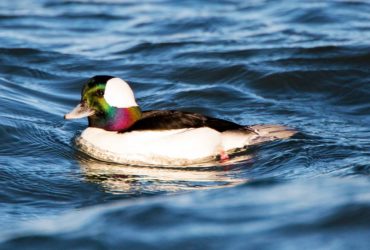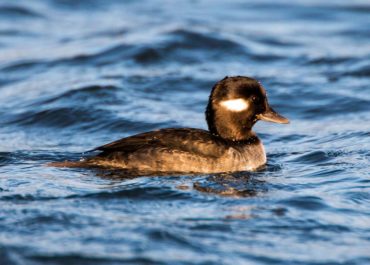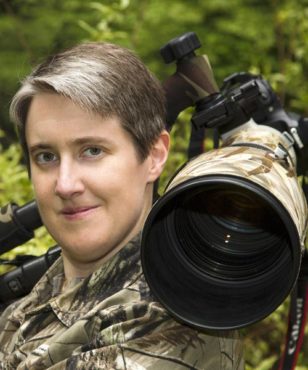
With winter fast approaching, West Sound’s waterways are increasingly teeming with ducks that breed in the Arctic. For them, the ice-free waters of Washington feel like the tropics.
Ducks come in various shapes, sizes and colors. They are split into two groups: dabbling ducks and diving ducks.
Dabbling ducks feed in shallow water on aquatic insects and plants they find just below the surface by employing the “bottoms up” method used by swans and geese. They include wood ducks, mallards and wigeons.
Diving ducks stay farther offshore, where some species swim as much as 200 feet below the surface to feed on fish and arthropods. To swim under water, diving ducks have shorter wings and larger feet than dabbling ducks. They include mergansers, scaups and goldeneyes.
One of the most endearing of these underwater specialists is the bufflehead. With a 21-inch wingspan and a body length of 15 inches, it’s the smallest diving duck in North America. The bufflehead (named for its large, buffalo-shaped head) winters on bodies of freshwater and saltwater throughout Washington. It’s a common resident of West Sound from fall to spring.
From a distance, the male bufflehead looks black and white. It has a black back and a large, white patch on the back of the head. But when observed from close range in direct sunlight, the front and base of the male’s head is not black, but rather a stunning, iridescent rainbow featuring prominent green and purple tones.
The female lacks iridescent colors and instead sports black and gray tones that flash hints of brown in direct sunlight. A white eye patch contrasts nicely with her dark plumage. Both sexes have a white wing patch that is visible in flight.
The bufflehead is specially designed for its lifestyle. Its feet are positioned on the back of the body to allow for easier diving. This makes walking on land awkward, so buffleheads rarely visit the shore.
Unlike the larger diving ducks, buffleheads don’t use their wings while swimming under water. They keep their wings folded tightly to their sides and rely upon their feet for propulsion. When ready to return to the surface, the bufflehead stops kicking and looks up toward the surface, where it quickly bobs up like a cork. Dives usually last for 12 seconds.
Buffleheads typically consume their food under water. They have a varied diet that includes aquatic invertebrates and larvae, as well as crustaceans and mollusks. They may also eat small fish eggs, snails and crabs.

The male’s courtship display involves flying by a female and skidding to a stop on the water’s surface with his crest raised and head bobbing. Multiple males often compete for a lone female on a pond, wildly flapping their wings and repeatedly bobbing their heads to get her attention.
Females return to their place of birth to breed. A few pairs nest in northeastern Washington. The majority breed in the boreal forests of Canada and Alaska.
Bufflehead nests are placed within 25 yards of a pond or lake. Tree holes created by northern flickers offer ideal nest sites since larger-cavity nesting ducks can’t fit into the 3-inch opening. Clutch size ranges from four to 17 eggs. Most broods have about nine chicks.
The female incubates the eggs and cares for the ducklings while the male departs for a place where he can molt his feathers. They will find each other again the following year, as the bufflehead is one of the only monogamous ducks. Pairs often use the same nest for several years.
Only a day or two after hatching, the chicks must take a leap of faith from their cozy nest, as high as 40 feet, to the forest floor. Then they follow their mother to the water. She watches over the vulnerable ducklings for up to six weeks. It takes them two years to reach reproductive maturity.
Buffleheads are fiercely territorial on their breeding grounds. They will chase off intruders, even pursuing unwelcome buffleheads under water.
The spirited bufflehead flies low and fast over water and higher over land. Unlike larger diving ducks that have to run across the water before getting airborne, buffleheads can quickly lift off from the surface to take flight. Migrating buffleheads usually fly at night.
Because of their diminutive size, buffleheads are susceptible to predation by bald eagles, hawks, falcons and owls, as well as minks and weasels. Wintering flocks often have a sentinel who watches for predators while the others dive for food.
Bufflehead populations are stable but are always at risk of losing nesting habitat to clear-cutting. Contaminants in the water present another threat.
This winter, head to the nearest lake or bay to see the always-entertaining bufflehead. Easy to find and simple to identify, this small, charming duck can introduce anyone to the joy of birding.
























